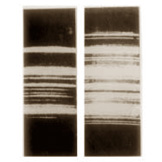What are the changes in bond lengths and strengths of specific residues and the peptide backbone during membrane protein folding and peptide insertion into a synthetic vesicle? Ground-state mode-specific alterations in aromatic amino acids and amide bonds due to changes in structure and local environment will be monitored using UV resonance Raman (UVRR) spectroscopy. Protein absorption in the near-UV region of ~230-300 nm is dominated by tryptophan, tyrosine and phenylalanine residues. Therefore, it is relatively straightforward to obtain vibrational spectra of these amino acids without spectroscopic congestion from the rest of the protein and bulk buffer solution. The sensitivity of normal mode frequencies and relative intensities to the surrounding allows UVRR spectroscopy to probe the local microenvironment, including hydrogen bonding states of aromatic residues. Localization of the aromatic amino acids to the bilayer-water interface suggests that these residues in fully folded membrane protein will have drastically different vibrational properties relative to a fully denatured aqueous state. UVRR spectroscopy may also be used to obtain secondary structure information. Shifting the excitation wavelength towards 200 nm enhances resonance with the electronic transition of amide bonds and may reveal relative distributions of α-helices and β-sheets. This technique has been applied to a variety of problems in physics, biology, and chemistry. We are currently using UVRR and visible RR spectroscopy coupled to a host of other optical and magnetic techniques to probe topics in biophysics.
Return to main research page |

